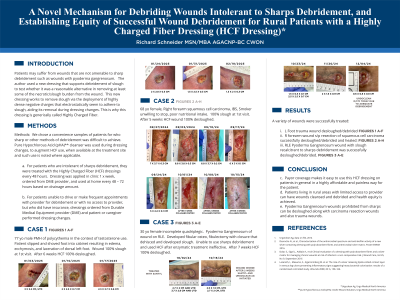Case Series/Study
(CS-146) A Novel Mechanism Using Highly Charged Fibers (HCF) for Debriding Wounds Intolerant to Sharps Debridement: Establishing Equity of Successful Wound Debridement for Rural Patients
Friday, May 2, 2025
7:45 PM - 8:45 PM East Coast USA Time

Debashish Chakravarthy, Phd
Introduction: Patients have wounds that are too painful to have sharps debridement, or may have wound types that are not indicated for sharp debridement, such as pyoderma gangrenosum wounds. Many patients cannot afford the expense of drugs that debride wounds non surgically, and rural patients in particular cannot always access a provider for a sharp wound debridement. Accessible, effective, and pain free debridement methods are highly desirable, and we tested a new entrant in the debridement supportive space. This dressing uses Highly Charged Fibers (HCF) to electrostatically eliminate slough from the wound bed in a gentle fashion.
Methods: We identified patients who needed debridement but were intolerant to sharp debridement. They were treated with a HCF dressing every 48 hours. The dressing was applied in clinic 1 x week, ordered from DME and used at home every 48 – 72 hours based on drainage amount. For patients in rural locations without the ability to drive to clinic/get home care, but with insurance, dressings were ordered from DME and patient or caregiver performed dressing changes
Results: Three types of wounds that are not suited/not accessible for sharp debridement were cleansed of wound slough/debris with the Highly Charged Fiber (HCF) dressing. Pyoderma, squamous cell carcinoma, and burn wounds were successfully treated and debrided.
Discussion: Easy access, Medicare support, and gentle patient experience are associated with the new Highly Charger Fiber (HCF) dressings, and it appears to provide a viable, new choice in the difficult area of wound debridement for highly vulnerable and locationally difficult to reach by clinicians.
Methods: We identified patients who needed debridement but were intolerant to sharp debridement. They were treated with a HCF dressing every 48 hours. The dressing was applied in clinic 1 x week, ordered from DME and used at home every 48 – 72 hours based on drainage amount. For patients in rural locations without the ability to drive to clinic/get home care, but with insurance, dressings were ordered from DME and patient or caregiver performed dressing changes
Results: Three types of wounds that are not suited/not accessible for sharp debridement were cleansed of wound slough/debris with the Highly Charged Fiber (HCF) dressing. Pyoderma, squamous cell carcinoma, and burn wounds were successfully treated and debrided.
Discussion: Easy access, Medicare support, and gentle patient experience are associated with the new Highly Charger Fiber (HCF) dressings, and it appears to provide a viable, new choice in the difficult area of wound debridement for highly vulnerable and locationally difficult to reach by clinicians.

.jpg)